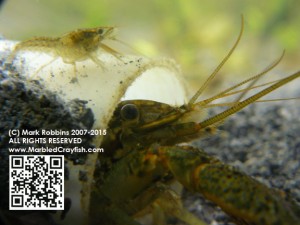 There is a growing use of Self-Cloning Marbled Crayfish – around the world – in the area of Hydroponic Gardening, and AQUAPONICS. (see Wikipedia)).
There is a growing use of Self-Cloning Marbled Crayfish – around the world – in the area of Hydroponic Gardening, and AQUAPONICS. (see Wikipedia)).
We have found Marbled Crayfish to be SUPERIOR in the use of AQUAPONICS systems. By themselves, they produce great volumes of fertilizer in smaller aquariums. In larger aquariums, they not only produce superior fertlizer, but also serve as feeders to trout, bass, tilapia, oscars, pacu, catfish, and other fishes suitable for eating by humans.
The Marbled Crayfish sold from this website are guaranteed to be FREE OF PATHOGENS, which is why we are the chosen supplier to many University BioLabs of superior grade Marbled Crayfish. For an Aquaponic system, this means that they will not bring disease to the fishes and plants in an Aquaponic System. The Marbled Crayfish is considered an “invasive species” outside of the USA, as are Tilapia fish, and many other fishes. Therefore we will not ship outside the USA. However we have gathered a great many success stories from individuals, universities, and commercial farming operations which use our Marbled Crayfish in Aquaponic and AquaFarming systems. Contact us today to get your own superior grade, pure Marbled Crayfish direct from the source!
Hydroponic gardening is a popular means to grow plants and gardens in limited spaces, both indoors and outdoors. By flushing the roots of plants with nutrients, your produce a dramatic yield of vegetables and flowers, with much greater results than growing in soil, using a very small amount of space. This is one reason why so many stores and websites are popping up to sell the basics to create a hydroponic garden. However, with the next step of AQUAPONICS, you use aquariums filled with living animals to supply a steady flow of NATURAL fertilizer to plants, which is proven superior to the use of chemicals.
Marbled Crayfish not only provide an endless supply of “feeders” for edible fishes (catfish, tilapia, bass, perch, trout, etc). Additionally, they are a particularly good source of natural fertlizer, because as a species, they are particularly dirty. A normal aquaruim will require two or more filters just to keep up with them. Their natural excretions include not only excrement, but the shedding process which allows them to grow also excretes a filmy mucus, which all plants love as fertilizer. Plus, with a relatively small aquarium of 40 gallons, you can run multiple aquaponic systems, resulting in very healthy plants and a never-ending supply of Marbled Crayfish. You can also siphon off Marbled Crayfish aquarium water to feed any plants grown in the soil, as seasons allow. This is extremely successful for potted plants using soil, or pouring straight into the ground when watering soil-based plants. However, AQUAPONICS involves a completely contained system that operates year-round, in soil-free conditions.
A basic Aquaponics system uses a very simple principle. “Dirty” Water is extracted from the aquarium by a pump and tubing (or a commercial canister filter with no filtration medium), and the water from the tank is constantly released into a “tray” containing lava rock or other medium. Potted plants, also in lava rock or other medium, are set into these trays. The water from the aquarium washes through the trays, trapping the natural fertilizer into the lava or other growing medium. This is absorbed up into the potted plants without drowning the roots. As the water passes through the trays, a “sump pump” draws water out of the opposite end of the tray and returns water back into the aquarium. This acts to filter the aquarium water and feed the plants at the same time. Larger aquarium systems can grow food fishes, such as bass and trout, as well as huge quantities of vegetables. This can be done on any scale – from an apartment sized setup, to a garage sized setup, to greenhouses of various sizes. Indoor systems usually use high powered lighting, such as high pressure sodium lights, for the growth of plants.
We have a website for Texas-based small aquaponics systems for use in apartments, homes and offices. See http://www.AquaponicsTexas.com

